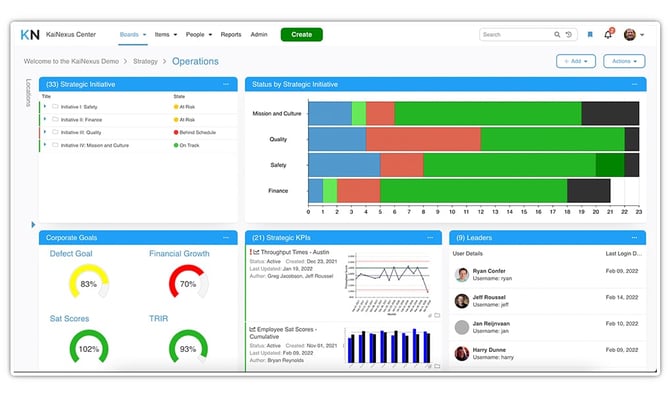I n today’s hyper-competitive and rapidly changing environment, organizations must find innovative ways to improve quality, reduce waste, and get products to market quickly and efficiently. To do so, many organizations of all types are turning to the tools and techniques that manufacturing companies have used for decades to achieve operational excellence. Today, hospitals, construction companies, software developers, and even educational institutions are adapting ideas from the Toyota Production System and Lean manufacturing to suit their needs.
n today’s hyper-competitive and rapidly changing environment, organizations must find innovative ways to improve quality, reduce waste, and get products to market quickly and efficiently. To do so, many organizations of all types are turning to the tools and techniques that manufacturing companies have used for decades to achieve operational excellence. Today, hospitals, construction companies, software developers, and even educational institutions are adapting ideas from the Toyota Production System and Lean manufacturing to suit their needs.
One of the most popular techniques is Standard work.
What is Standard Work?
Standard work is the documented best practice for performing any process or task within the process. Standard work, also called Standard work instruction, is considered the bedrock of quality improvement. When a process is completed consistently, no matter who the operator is, can you measure results and decide what actions to take to improve it?
While making sure everyone completes a process precisely the same way every time may seem like the antithesis of innovation, the opposite is true. If everyone performs to the Standard, you have a baseline against which to measure incremental improvements and can make intelligent decisions about what to change.
Typically, Standard work is:
- Created by the process operators
- Documented and accessible to those performing the work
- Always kept up to date
- Illustrated when applicable
The Many Benefits of Standard Work
The use of Standard work is widespread because it offers many benefits to organizations and workers. With Standard work in place:
- Operations are predictable no matter who is doing the work
- Training and onboarding of new employees is simplified
- Quality and customer satisfaction are improved
- The results of improvements are easily measured
- Costs are forecastable
- Problem-solving is streamlined
- Employees develop a sense of ownership of the process
- Managers can focus on strategic objectives and innovation
Why Consider Standard Work Software
It is possible to implement Standard work without software to support it, but because Standard work is an essential part of quality improvement, it makes sense to give your team the best shot at success.
Here are some of the essential features of Standard work software and why they accelerate positive change.
Capture and Manage Opportunities for Improvement
Your organization has many processes, probably many that don’t get a lot of attention. Implementing Standard work is no small task, and it will take time to collect all of the processes and begin documenting the current best practices. Standard work software becomes the unified collection point for every project. Front-line employees can enter each process as an opportunity and embark on a systematic process of creating the Standard for each one.
Store Related Assets and Make Them Accessible
As we mentioned, one of the Standard work requirements is that it is accessible in the place where work is done. With Standard work software, all relevant assets, including manuals and images, along with any current work in progress information, are available from anywhere on any device. This is particularly useful if you have people who travel or work from home. In workspaces where people don’t have access to computers or mobile devices, kiosks can be used to provide access.
Proactively Manage Change
Whether your team is in the process of first developing the Standard for a specific process, or they are working to improve it, it is valuable to have workflow tools that provide alerts and notifications to the right people when action is required. This ensures controlled change and unhindered forward progress.
Search for Similar Processes or Improvements
There are probably very similar processes within your organization. While each will have some unique aspects, there is likely some similarity and things the people can learn from the Standards developed by other teams.
Standard work software makes it easy for people to search for similar processes and build on the best practices already proven out by others. It may also help people point out ideas that don’t work to avoid making mistakes more than once.
Report on Results, Engagement, and Activity
Look for Standard work software solutions with visual management tools that make it easy to see the progress of your Standard work implementation and future improvement work. The best solutions allow you to track the impact of improvements, the engagement of your workforce, and the current improvement activities underway. In addition, configurable dashboards give you instant insight into the health of your improvement culture.

More Best Practices for Standard Work
Once you have Standard work in place and use a platform to support it, there are a few more best practices to consider.
Use Structured Improvement to Change the Standard
Standards are not set in stone. In fact, they are made to be changed and improved. However, changes must be made thoughtfully in a controlled manner. The PDSA improvement cycle is an excellent choice when a new improvement is considered.
Go to the Gemba and Observe
Another tool that you can borrow from the manufacturing sector is the Gemba walk. In a Gemba walk, the manager goes to the place where the Standard is being applied and sees it in action. This is an excellent opportunity to show respect for the workers, observe real-world conditions, and potentially gather ideas for improvement.
Review Standards Regularly
Even if a process is running smoothly, it is essential to review the Standard from time to time to look for opportunities for innovation. How often this happens depends on the type of process and the nature of the organization, but establishing a regular cadence will make sure that this review does not slip through the cracks.
Recognize and Reward Your Innovators
Because Standard work is about empowering workers to own the processes they operate and do their best work, it is critical to recognize and reward those who are actively engaged in continuous improvement. Some Standard work software even includes the capability of broadcasting improvement so that the innovative spirit can spread.
Because Standard work is such a crucial element of operational excellence, it pays to invest in technology to manage, measure, and support it.




Add a Comment